Introduction
The largest volcanic explosion in the late Pleistocene occurred in Lake Toba, approximately 72,500 (+- 3000) years ago. The super eruption of Toba has attracted a lot of scientific disrepute due to various reasons. When viewed from space, the caldera is observed as one of the biggest volcanic craters on earth, since it measures over 100km.
On the steep was of the caldera is lake Toba. This lake is said to be the largest volcanic lake on earth. Various scientists including Gasparotto, Spadaforab, Summac, Tateoc, Spadafora and Summa (567) and Jones, Gregory and Stott (725) sugest that the eruption resulted in a massive volcanic winter that caused a human population bottleneck.
Super-volcanoes are colossal eruptions that are referred to as super-eruptions, and they vary from other catastrophes like tsunamis or earthquakes since their environmental outcomes threaten global civilization (Buhring and Sarnthein 277).
These super eruptions are known to occur once in about 500,000 years, like the largest Yellowstone eruption in the USA, or the Toba eruption in Indonesia.
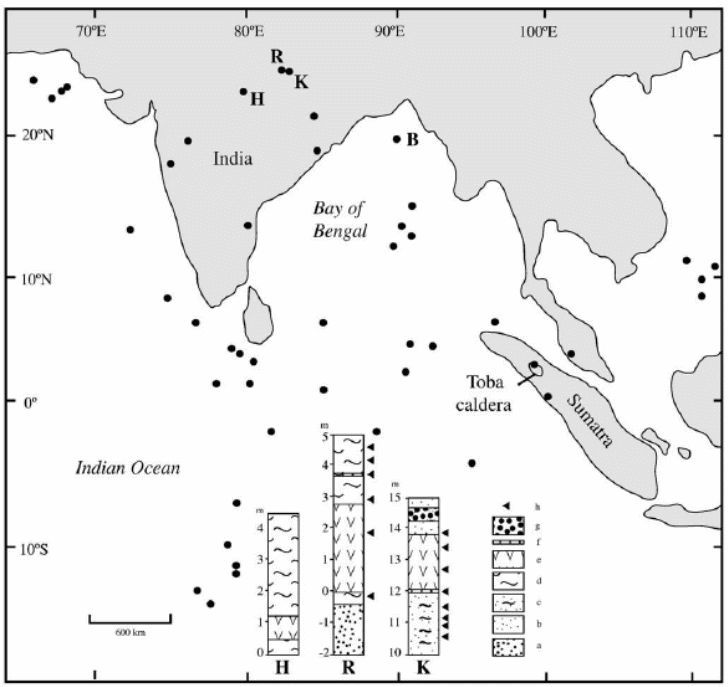
Figure 1: Distribution of volcanic ash from the 73 ka Toba super-eruption showing location of marine cores and sections sampled in India
According to Ninkovich, Sparks and Ledbetter (5), super-eruptions occur in areas of the earth where the tectonic plates collide. Ambrose, Williams and Chattopadhyaya (167) also suggest that super-eruptions can occur in areas where hot material wells up from the deep earth interior below a continent.
According to Williams and Clarke (633), there are many regions on earth that are suspected of volcanic activity, like Andes and Japan. A cause for concern is the location of super-volcanoes within or near continents, which impies that these vents are situated in areas that have crowded populations (Lang, Leuenberger & Schwander 934).
This paper looks at the eological setting of Toba, in an effort to understand the super eruption and its probable effects. In doing this, this study seekd to validat that the eruption resulted in the putative bottleneck.
Table 1: Particle size distribution of the YTT ash at the Rehi section, Son valley, India.
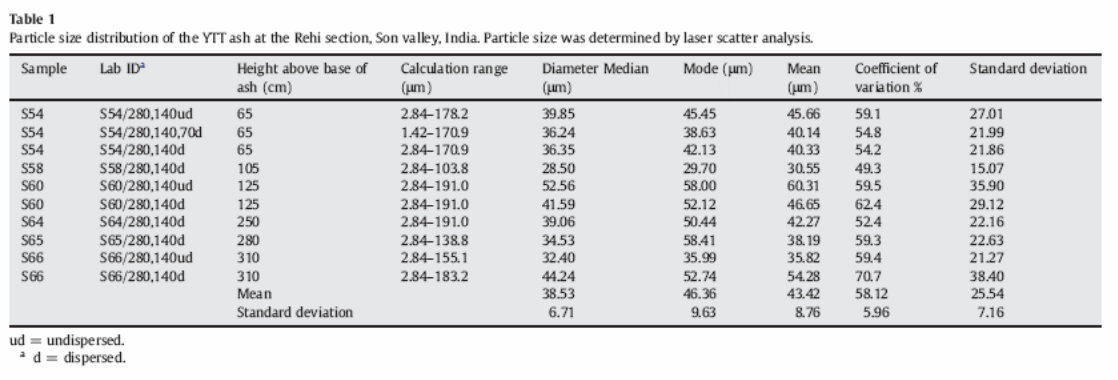
Geological Setting of Toba
Toba is located in western Indonesia, in the island of Sumatra, in the north province. It is found in the Barisan Mountains as shown in figure 1.
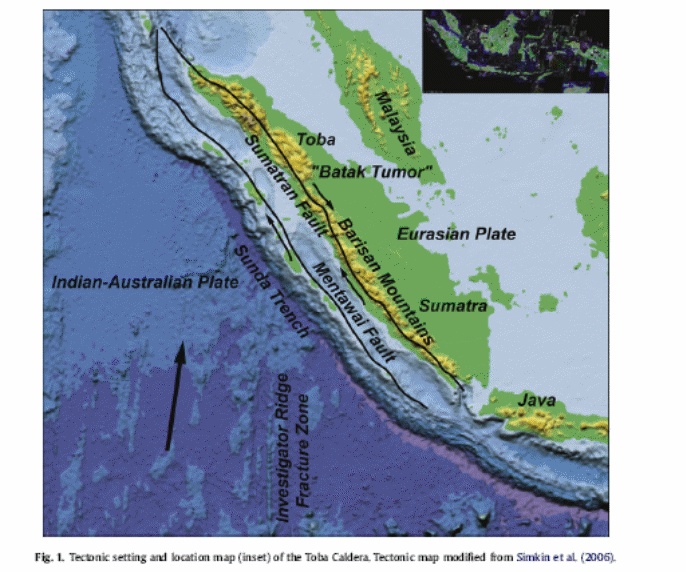
Fig. 2: Tectonic setting and location map (inset) of the Toba Caldera. Tectonic map modified from Simkin et al. (2006).
These mountains comprise metamorphic rocks, Quaternary volcanic and Miocene sedimentary rocks (Ambrose 274).
De Silva (671) suggests that Indian-Austrlain plate located beneath the continental Eurasisn subdues a the rate of aproximately 5.5cm.year, towards the Sunda trench, which has resulted in the formation of an active volcanic (Gathorne-Hardy and Harcourt-Smith 228).
Sadler and Grattan (186) suggest that the crust is about 30 to 39 km thick under Toba, with a visible depth of around 125 km (De Silva 671). This is an indication of a 30 degrees subduction angle, which has caused the formation of two parallel faults that lie between the trench and vulcanic arc.
One of the faults, the vertical Sumatran, marks the border between the Eurasian plate and most of the Volcanic arc and fore arc basin on the north east and south west respectively.
The other fault, Mentawai, forms the division between the fore arc basin and the fore arc accretionary sridge complex in the southwest direction (Erwin & Vogel 894).
According to Westgate, Shane and Pearce there is a dxtral displacement aong the Sumatran Fault. The displacement extends for about 150 km. It is referred to as the Investogator Ridge Fracture Zon (IFZ), with a subduction that is directly nelow Toba.
The results of a geometry assessemt of the subduction slab beneath Toba by Chesner et. al. (201) suggest that there is a bend in the slab that coincides with Toba.
The study also showed high seismicity along the subducted portion of the IFZ, which suggests the probability of IFZ concentrating volatile release into the mantle wedge beneath Toba (Chesner et. al 201).
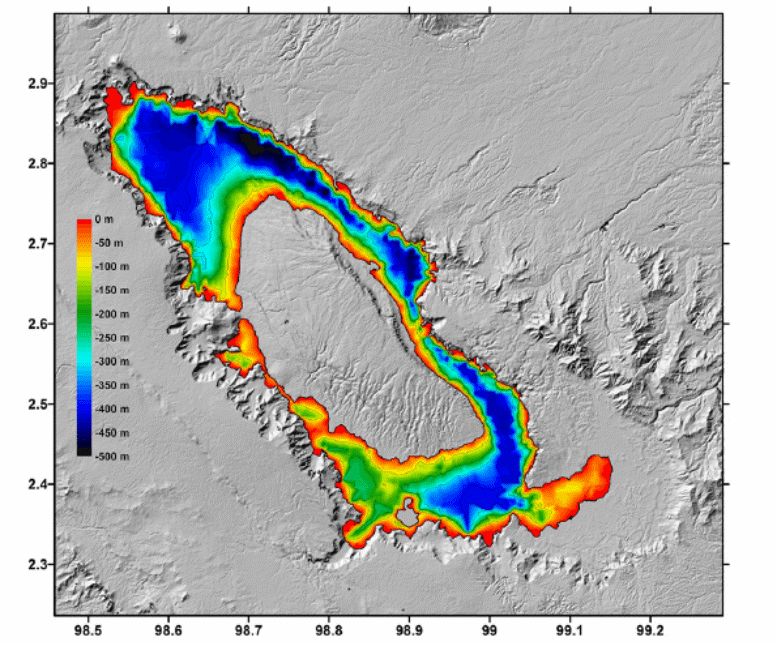
Figure 3: Bathymetric map of Lake Toba. Depth is represented by isochromes; 100 m contour lines are plotted for reference.
The Toba Super eruption
The single event of the Toba eruption resulted in a minimum magma eruption of 2,800 km. The magnitude of the eruption was noted as 8.8, which made it one of the largest eruptions in the Quaternary geologic period.
The super eruption caused an injection of over 1015 kg of fine ash into stratosphere, while the pyroclastic flows extended for an area of approximately 105 km2 with lava reaching both the Malacca straits and the Indian Ocean.
Kelly, Jones and Pengqun (550) suggest that there are layers of tephra in India, at a location that is over 3000 km away from Toba.
The ignimbrite extended from one coast to the next, causing a wide area of the North Sumatra to be drowned. Moreover, there was an aerosol cloud and dust cloud that covered the globe.
The possible effects of the cataclysmic eruption include the total obliteration of both flora and fauna in North Sumatra by the ignimbrite, considerable effects on flora and fauna by ash fall in Southeast Asia, as well as, the regional or global change in temperature and effects on the environment.
The Toba Catastrophist Theory
The Toba catastrophe theory suggests that the super-eruption resulted in the population decline. Scientists suggest that the super-eruption is the worst disaster that human beings have ever been faced.
The volcano eruption in Toba resulted in the exhaustion of large amounts of fine ash and aerosols into the atmospheres.
The expulsion of these fumes is compared to nuclear-winter situations (Samuel, Harbury, Bakri, Banner & Hartono 350), since the global land temperatures fell by 5-15 degrees Celsius, and the surface of the ocean, and other low altitudes, cooled by 2-6 degrees Celsius.
This scenario is thought to have prolonged for several years. As a result, the persistence of soot in the atmosphere for 3 years or so may have resulted in a cooling of the climate (Pattan, Shane & Banakar 244).
This climatic change is though to have extended for several decades, due to the climatic feedbacks such as increased snow cover and sea ice, resulting in less solar radiation reaching the earth’s surface.
Consequently, the earth’s temperature remained low since the ground and atmosphere were not heated up. Researchers suggest that the human population faced a bottleneck during this period, due to the rapid decline in the number of females by about 500, in a population that was thought to have only 4000 individuals (Hawks, Hunley, Lee & Wolpoff 18).
Data suggests that the eruption caused a peak in sulfur aerosol levels in the GISPs ice core, in addition to the global climatic change. According to ice core data, the weather was cooler for several centuries after the eruption of Toba. Based on the estimates, the Toba eruption resulted in the near extinction of modern humans.
Ambrose, Williams and Chattopadhyaya suggest that this led to the human population, though Oppenheimer (1593) provides an alternative hypothesis, arguing that the Toba super-eruption did not have a significant effect on human existence.
Oppenheimer (1593) suggests that human beings should not have been the only ones facing termination. According to Rose and Chesner (913), the Toba induced winter should have resulted in an environmental catastrophe resulting in a population crash of more specialised ecological flora and fauna, causing them to be extinct, in a similar manner that it affected human population.
In support of this notion, Gates and Ritchie suggest that the Toba super-eruption did not lead to the extinction of any mammal.
In adtion to this, studies by Gathorne-Hardy and Harcourt-Smith (228), on the effects of super-eruptions on flora and fauna suggest that they do not result in mass extinctions, which disapproves the Toba catastrophe theory.
According to Gasparotto, Spadafora and Summa (569), a bottleneck in human populations would have assumed the shape of an hour glass, causing the human population to crash at 73.5 Ka and then expand again later.
According to Schulz, Emeis and Erlenkeuser (22), the studies on human genome that analyse nuclear sequences suggest that the Y chromosome and mitochondrial DNA support the existence of a bottleneck.
Consequently, Robock, Ammann and Oman (114) support the possibility of a bottleneck, though they raise concerns about the time when the bottleneck is expected to have occurred.
Some research suggests that the phenomena occurred over 2 million years ago (Petraglia, Clarkson and Ditchfield 114), while other researchers provide evidence of a long period of stasis that was followed by a population expansion around 75,000 years ago.
The different opinions with regard to the bottleneck differ on the timing of the event, which raises concerns as to whether it was caused by the super-eruption at Toba. Differences also arise based on the shape of the bottleneck, in terms of an hourglass model or a short bottle with a long neck.
The hourglass model suggests a short period of human population decrease, followed by an expansion, while the long neck period indicates a proonged period of winter, and low population density (Rampino and Ambrose 274).
However, the hourglass shaped bottleneck is dispreuted due to its timing of the expansion, which is proposed to have a minimum range of 50,000 years. Consquently, the super-eruption of Toba was unlikely to have resulted in the bottleneck (Rampino and Self 75).
In addition to this, studies by McBrearty and Brooks on the Middle and Late Pleistocene human sites in Africa show that by 73.5 Ka, modern humans occupied a variety of habitats around the African continent.
The human beings were also noted to be considerably adaptable and resourceful, with the ability to hunt and perform other tasks requiring skill (Westgate, Shane and Pearce).
Conclusions
In conclusion, it has been established that the super-eruption of Toba resulted in a severe climate change; however, there is inadequate evidence to support the notion that it caused a bottleneck in human population. Studies suggest that the effects were localized.
In addition to this, research shows that the super-eruption had negligible effect on the Asian population, and none in Africa. During the time, human beings were adaptable, mobile and well equipped, which made them fully capable of handling the effects of the Toba phenomena.
Moreover, the studies suggest that the super-eruption did not result in the extinction or decline of any fauna. Consequently, it is evident that the super-eruption of Toba did not result in human, flora or fauna bottleneck (Thornton 34).
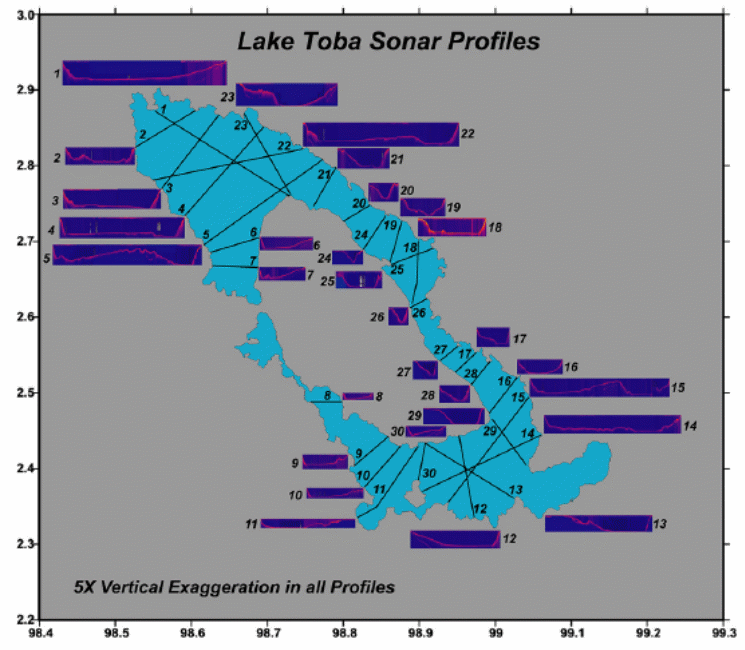
Figure 4: Sonar profiles along selected transect lines.
Works Cited
Ambrose, Stanley H., Martin Anthony J. Williams and Umesh Chandra Chattopadhyaya. “Environmental impact of the 73 ka Toba eruption reflected by paleosol carbonate carbon isotope ratios in central India.” Quaternary International. 1.8 (2007): 167 –168. Print.
Ambrose, Stanley H. “Did the super-eruption of Toba cause a human bottleneck? Reply to Gathorne-Hardy and Harcourt-Smith.” Journal of Hu man Evolutio. 45 (2003): 231 – 237. Print.
Buhring, Christian and Michael Sarnthein. “Toba ash layers in the South China Sea: Evidence of contrasting wind directions during eruption ca. 74 ka.” Geology. 28 (2000): 275–278. Print.
Chesner, C.A., Rose, W. I., Deino, A., Drake, R., Westgate, J.A. “Eruptive histo ry of earth’s largest Quaternary caldera (Toba, Indonesia) clarified.” Geology. 19 (1991): 200– 203. Print.
De Silva, Shanaka. “Arc magmatism, calderas and supervolcanoes.” Geology. 36 (2008): 671 – 672. Print.
Erwin, Douglas H. and T. A. Vogel. “Testing for causal relationships between large pyroclastic volcanic eruptions and mass extinctions.” Geophysical Research Letters. 19.9 (1992): 893–896. Print.
Gasparotto, Giorgio, Elena Spadaforab, Vito Summac and Fabio Tateoc. “Contribution of grain size and compositional data from the Bengal Fan sediment to the understanding of Toba volcanic event.” Marine Geology. 162.2-4 (2000): 561 – 572. Print.
Gates, Alexander E. and David Ritchie. Encyclope dia of Earthquakes and Volcanoes, 3rd edition. New York: Facts on File. 2007. Print.
Gathorne-Hardy, F.J. and W.E.H Harcourt-Smith. “The super-eruption of Toba, did it cause a human bottleneck?” Journal of Human Evolution. 45 (2003): 227– 230. Print.
Hawks, John, Keith Hunley, Sang-Hee Lee and Milford Wolpoff. “Population Bottle necks and Pleistocene Human Evolution.” Molecular Biology and Evolution. 17.1 (2000): 12–22. Print.
Lang, C., M. Leuenberger and J. Schwander. “Rapid temperature variation in Central Greenland 70,000 years ago.” Science. 286 (1999): 934–937. Print.
Jones, G.S., R.S.J.,Sparks and P.J. Valdes. “An AOGCM model of the climate response to a volcanic super-eruption.” Climate Dynamics. 25 (2005): 725 – 738. Print.
Jones, M.T., R.S.J. Sparks and P.J. Valdes. “The climatic impact of supervolcanic ash blankets.” Climate Dynamics. 29 (2007): 553– 564. Print.
Kelly, P.M., P.D. Jones and J. Pengqun. “The spatial response of the climate system to explosive volcanic eruptions.” International Journal of Climatology. 16 (1996): 537 – 550. Print.
McBrearty, Sally and Alison S. Brooks. “The revolution that wasn’t: a new interpretation of the origin of modern human behavior.” Journal of Human Evolution. 39.5 (2000): 453–563. Print.
Ninkovich, D., R.S.J. Sparks and M.T., Ledbetter. “The exceptional magnitude and intensity of the Toba eruption, Sumatra: an example of the use of deep-sea tephra layers as a geological tool.” Bulletin Volcanologique. 41.3 (1978): 1 –13. Print.
Oppenheimer, C. “Limited global change due to the largest known Quaternary eruption?” Quaternary Science Reviews. 21.14-15 (2002): 1593 –1609. Print.
Pattan, J.N., Phil Shane and V.K. Banakar. “New occurrence of youngest Toba tuff in abyssal sediments of the central Indian Basin.” Mar. Geol. 155 (1999): 243–248. Print.
Petraglia, M., R., Korisettar, N., Boivin, et al. “Middle Pleistocene assemblages from the Indian subcontinent before and after the Toba super-eruption.” Science. 317 (2007): 114 –116. Print.
Rampino, M.R. and S. Self. “Climate-volcanism feedback and the Toba eruption of 74 000 years ago.” Quaternary Research. 40 (1993): 269– 280. Print.
Rampino, M.R. and S.H Ambrose. “Volca nic winter in the Garden of Eden: The Toba supereruption and the late Pleistocene human population crash.” Volcanic Hazards and Disasters in Human Antiquity: Geological Society of America. 345 (2000): 71 – 82. Print.
Robock, A., C. Ammann, L. Oman, D. Shindell, S. Levis, and G. Stenchikov. “Did the Toba volcanic eruption of 74 ka B.P. produce widespread glaciation?” Journal of Geophysical Research (2009): 114. Print.
Rose, W.I. and C.A. Chesner. “Dispersal of ash in the great Toba eruption, 75 ka.” Geology 15.10 (1987): 913– 917. Print.
Sadler, J.P. and J.P. Grattan. “Volcanoes as agents of past environmental change.” Global and Planetary Change. 21.1-3 (1999): 181 – 196. Print.
Samuel, M.A., N.A.Harbury, A. Bakri, F. Banner and L. Hartono. “A new stratigraphy for the islands of the Sumatran Forearc, Indonesia.” Journal of Asian Earth Sciences.15 (1997): 339–380. Print.
Thornton, Ian.W.B. Krakatau, the destruction and reassembly of an island ecosystem. Cambridge, Massachusetts and London: Harvard University Press. 1996. Print.
Schulz, H., et al. “The Toba volcanic event and interstadial/stadial climates at the marine isotope stage 5 to 4 transition in the northern Indian Ocean.” Quaternary Research. 57 (2002): 22 – 31. Print.
Westgate, J.A., et al. “All Toba tephra occurrences across peninsular India belong to the 75, 000 yr B.P. eruption.” Quaternary Research. 50 (1998): 107 –112. Print.
Williams, M.A.J. and M.F. Clarke. “Late Quaternary environments in north central India.” Nature. 308 (1984): 633– 635. Print.
Zielinski, Gregory A. “Use of paleo-records in determining variability within the volcanism-climate system.” Quaternary Science Reviews. 19.1-5 (2000): 417–438. Print.
List of illustrations
Tables
Table 1: Particle size distribution of the YTT ash at the Rehi section, Son valley, India
Figures
Figure 1: Distribution of volcanic ash from the 73 ka Toba super-eruption showing location of marine cores and sections sampled in India
Fig. 2: Tectonic setting and location map (inset) of the Toba Caldera
Figure 3: Bathymetric map of Lake Toba. Depth is represented by isochromes; 100 m contour lines are plotted for reference.
Figure 4: Sonar profiles along selected transect lines